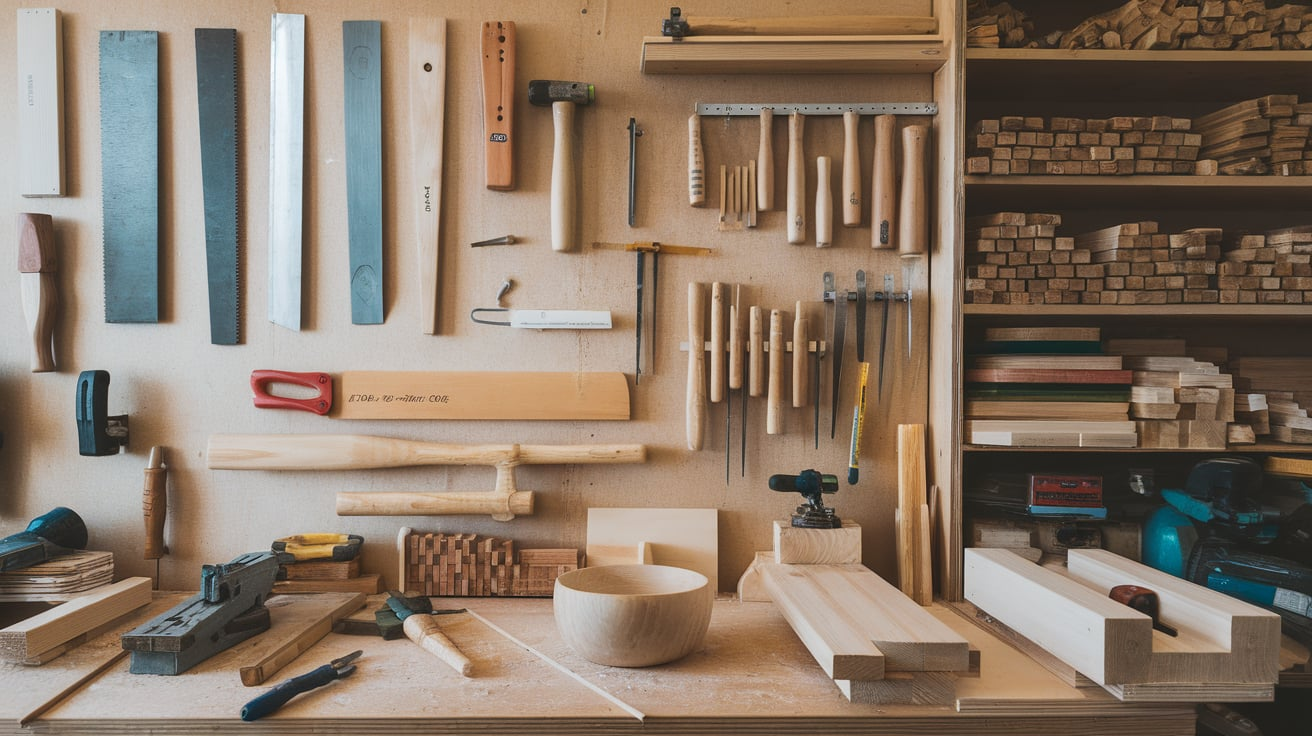If you’ve ever tried finding your drill bits in a cluttered corner while balancing a heavy slab of oak, then you already know—a well-planned woodworking shop layout is not a luxury; it’s a necessity.
Whether you’re working out of a two-car garage, a backyard shed, or a full-on commercial space, how you design the space will either make or break your creative flow.
This isn’t just about lining up tools in a row or having a workbench that doesn’t wobble. We’re talking workflow, efficiency, safety, storage, and those little creature comforts that make you want to spend hours in the sawdust-scented sanctuary.
1. The Classic U-Shaped Layout
Imagine wrapping your workspace around you like a warm flannel jacket. The U-shaped layout gives you maximum surface area within arm’s reach. Place your workbench at the bottom of the “U”, with tools and storage lining the sides. It’s efficient for solo work and allows you to pivot from sawing to sanding without walking miles.
2. The Assembly Line Setup
Borrow a trick from the factory floor: create a linear workflow where raw materials enter one side, and finished projects exit the other. Position your miter saw first, followed by the table saw, then assembly bench and finishing station. This setup is fantastic if you’re producing multiple pieces or run a side hustle.
3. The Center Island Workbench
Like a kitchen island but for building birdhouses instead of brunch. Placing a large, sturdy workbench in the center of your shop keeps you mobile and gives you 360-degree access to your projects. Great for detailed work and larger builds.
4. The Mobile Everything Strategy
Why glue your tools to the floor when they could be dancing on wheels? Equip your major tools—bandsaws, planers, drill presses—with locking casters. This gives you the ability to reconfigure your space on demand, making it adaptable to different projects and space constraints.
5. The Zone-Based Layout
Think of your shop as a city, and your tools as neighborhoods. Group them into zones: cutting, assembly, finishing, and storage. This not only improves workflow but keeps mess and dust contained to specific areas. Your finishing zone will thank you when it’s not coated in sawdust.
6. The Power Center Layout
Run your power supply like plumbing—strategically. Design your layout around centralized outlets or power poles. Avoid extension cords crisscrossing the floor like booby traps. Use drop-down cords from the ceiling to keep your workspace uncluttered.
7. The Wall-Hugger Layout
Ideal for tight or shared spaces, this layout keeps major tools and workstations along the walls. Fold-down tables and French cleat systems add versatility. It may not feel grand, but with smart storage, it’s highly functional.
8. The Grid System Layout
Divide your shop into a grid, giving each square a specific task or tool. This works well in square or rectangular spaces. You can visually map the entire shop, ensuring every inch serves a purpose. It’s the Marie Kondo approach—if a layout doesn’t spark joy, rework it.
9. The “Tool Triangle” Method
Inspired by the kitchen’s work triangle (fridge, stove, sink), apply it to your shop: table saw, jointer, planer. These three are often used in quick succession, so arrange them in a triangle for efficient material flow. Bonus: fewer steps means less fatigue.
10. Overhead Storage Efficiency
Don’t overlook the airspace above your head. Install overhead racks or ceiling-mounted shelves for storing seasonal lumber, clamps, or jigs. Keep heavy or frequently used items lower, and reserve the upper echelon for rarely touched tools.
11. Workbench with Built-In Storage
Your workbench can be more than just a surface. Build or buy one with drawers, cubbies, and clamp racks built-in. This turns your bench into a command center, where everything has a home, and you never waste time digging for tools.
12. Dedicated Lumber Rack Wall
A dedicated wall-mounted lumber rack is a must. Store different lengths and thicknesses horizontally, keeping species separated if needed. It frees up floor space and makes sorting a breeze. Bonus: nothing warps faster than lumber left on the floor.
13. Pegboard Power Wall
The pegboard is your silent shop assistant—ready, organized, and always on display. Use it to hang frequently used hand tools within sight and reach. Lay it out by task: all measuring tools together, all carving tools together. Add outlines or labels for easy return.
14. Dust Collection-First Layout
Design with dust in mind from the start. Place tools with high dust output near your central dust collector, and use short, straight runs for ducts. Even if you have a small shop vac setup, proper placement prevents clouds of sawdust from settling in corners.
15. Floor-Mounted Tool Stations
For larger, more permanent shops, install bolted-down tools (like the cabinet table saw) in positions that minimize wasted space and maximize reach. Think about infeed and outfeed zones—don’t let your planer’s output slam into the wall or your car bumper.
16. Fold-Down and Flip-Up Benches
When space is tight, be clever. Install fold-down benches or flip-up tables on hinges that can stow away when not in use. Perfect for garage setups that double as family storage areas. Suddenly, your car and your lathe can coexist peacefully.
17. Multipurpose Rolling Carts
Instead of static storage, consider rolling carts for glue-ups, hardware, sanding gear, or even your router table. They add flexibility and mobility to your layout. Just wheel them where you need them, and tuck them away after.
18. Finishing Room Separation
If you do finishing work, even occasionally, it pays to set aside a dust-free zone. Whether it’s a curtained-off corner, a spare room, or a tent setup, keeping this area clean and sealed prevents particles from ruining your hard-earned finishes.
19. The Bench-Against-the-Light Rule
Try to place your main workbench near a natural light source, ideally facing a window. Good lighting is critical for detail work, and daylight helps spot imperfections. Supplement with LED task lighting for evening or cloudy-day sessions.
20. Vertical Tool Storage
Use your vertical space creatively. Hang clamps, long-handled tools, and even folding ladders on vertical tracks. Slat walls or French cleats give you modular storage you can reconfigure as your tool collection (inevitably) grows.
21. Clear Pathways Rule
One of the most underrated layout strategies: leave 3 to 4 feet of walking clearance between major work zones. This isn’t just about comfort—tight pathways lead to tripping hazards, frustration, and inefficient movements.
22. Personal Comfort Zone
Set aside a little nook for yourself. Maybe it’s a stool with a thermos of coffee, a mini-fridge for snacks, or a speaker for music. Comfort leads to longer, more enjoyable sessions. Your shop should be a place you love being—not just a tool dungeon.
23. Soundproofing and Vibe Control
If your shop shares a wall with living space—or you like working late—soundproofing matters. Foam panels, weather stripping, and heavy curtains can dampen noise. Bonus: these add to the overall vibe, giving the shop a cozy, focused atmosphere.
24. Expansion-Ready Mindset
Leave room for growth. Whether it’s a future lathe or a new CNC setup, don’t max out every square inch. A smart layout anticipates change. Keep at least one wall or corner lightly used and available for future upgrades or tools you don’t yet own—but dream about.
Conclusion
Here’s the truth no one tells you: your woodworking shop layout isn’t a one-time deal. It’s a living, breathing part of your woodworking journey. As your skills grow, your workflow changes. What worked when you were just building boxes might not work when you’re crafting furniture.
Don’t be afraid to move things around. I’ve reorganized my shop four times in the last five years. One time, I flipped the whole layout because the sun was hitting my eyes during glue-ups. Another time, I reworked my dust collection just because my dog sneezed every time he walked in.


Leave a Reply